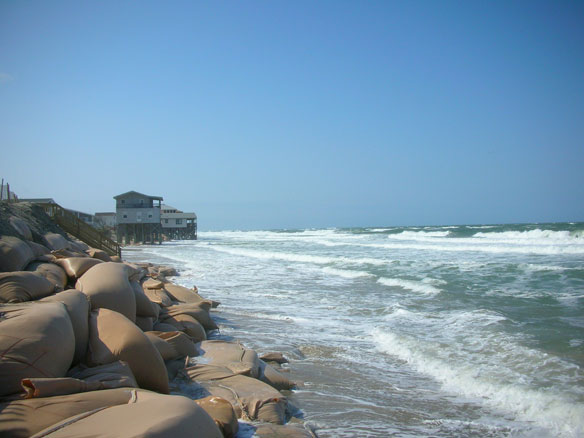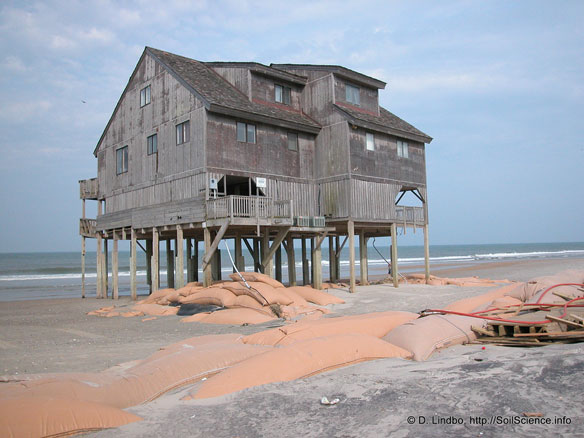
Beach Erosion at the Outer Banks of North Carolina . Photo source: ©© Soil Science
By Dr. Robert S. Young, director, Program for the Study of Developed Shorelines / Western Carolina University
The North Carolina Senate has approved legislation that would prohibit the state from considering projected sea level increases in its coastal management strategy. But a scientist involved in the debate argues that ignoring these projections will wind up costing North Carolina — and the rest of the U.S. — far more.
The state Senate in North Carolina voted overwhelmingly last week to pass a bill on sea level rise that has been widely reported in the national media. This bill prevents all state and local agencies from developing regulations or planning documents that consider the possibility of a significant increase in the rate of sea level rise in the future. In other words, when looking for guidance on how to protect the coastal economy and environment over the next century, the state’s planners may only look backward to historical data, not forward to expected changes in the Earth’s climate dynamics,
This bill has been widely ridiculed in many news outlets and science blogs, culminating with a biting satire of the proposal by Stephen Colbert on the Colbert Report. Personally, the whole thing just makes me sad.
The commission decided to ignore our report and recommended doing nothing about sea level rise.
I serve on the science panel that advises the North Carolina Coastal Resources Commission (CRC). Two years ago, the CRC solicited a report from the panel that would summarize the state of the science regarding sea-
level rise and recommend the expected increase that planners should consider when looking down the road to 2100. Our report included a detailed review of the published literature. It was externally peer-reviewed by out-of-state scientists. It contained no alarmist rhetoric or nightmare scenarios. The final recommendation was for the state to plan for 39 inches of sea level rise. This number corresponds well with expert reports produced in other states.
The reaction to our report was rapid and effective. NC-20, a group purporting to represent North Carolina’s coastal counties, attacked both the integrity of the science panel members and the body of sea level rise literature that was reviewed.

Photo source: ©© Soil Science
The rebuttal consisted largely of oft-repeated arguments pulled from the climate skeptic blogosphere, along with an adamant assertion that predicting the future is impossible. To the great surprise of those of us on the state’s science panel, these tactics have worked.
Following tremendous political pressure from NC-20, the Coastal Resources Commission decided to ignore our report and recommended doing nothing about sea level rise at this point. One would think that victory would have halted the debate, but it then prompted a state Senate committee to approve the legislation that passed the full Senate last week. The bill now moves on to the North Carolina House of Representatives.
All relevant, major scientific organizations in the United States — including the National Academy of Sciences, the Geological Society of America, the American Geophysical Union, and others — have issued statements indicating that the rate of sea level rise during the next 100 years is going to be considerably higher than that of the last 100 years, which was roughly 8 inches.
Assertions that talk of sea level rise will ruin the coastal economy are absurd.
North Carolina became the first state to directly contradict that overwhelming, peer-reviewed scientific consensus and to tie the hands of localities that would like to plan pro-actively for these changes. Virginia followed suit last week, with lawmakers there voting to fund a study on the state’s coastline only if references to climate change and sea level rise were expunged.
I have received many emails and phone calls from other scientists over the last two weeks pledging their assistance and volunteering to “come help educate the senators” in North Carolina. Sadly, I don’t think it will help. Quite frankly, those fighting the need to plan for accelerated sea level rise in coastal North Carolina do not want to be “educated.”

Coastal Erosion at the Outer Banks. Coastal storms, improper site management, and poor land use decisions can lead to catastrophic beach erosion. Photo source: ©© Soil Science
They assert that talk of sea level rise will ruin the coastal economy, impact insurance rates, and deter coastal development.
This is absurd.
First of all, the insurance industry is well aware of the science behind global climate change and the prevailing projections of sea level rise. They have funded much research into the science, hazards, and risks associated with sea level rise, coastal erosion, and storms. Nothing in the science panel’s report comes as a surprise to the insurers.
Second, the real and immediate threat along the North Carolina coast remains property damage resulting from storms, which may increase in intensity this century as the world warms. Some areas of the U.S. have experienced multiple storm impacts, yet their coastal economies continue to thrive.
The best way to prepare for sea level rise is to do a better job preparing for major storm impacts.
Dauphin Island, Alabama has been nearly wiped off the map several times in the last 30 years. Each time the barrier island was rebuilt, and the economy there chugs along. One might question whether this is good policy. But it is hard to imagine that something as abstract as a 100-year projection for rising sea level is going to impact the coastal economy when the reality of storm impacts has not slowed coastal growth.
No one has proposed evacuating the coast. If you are building a single-family home, or a subdivision, you probably don’t need to do anything other than what’s required by federal flood insurance — account for major storms and elevate new construction on pilings. In many respects, the best way to prepare for sea level rise over the next two to three decades is simply to do a better job of preparing for major storm impacts.
Some existing homeowners in low-lying areas do need to be concerned about future sea level rise. So does government at all levels. If you are building major infrastructure, a large port facility, or planning storm water runoff for a city, it would be foolish not to take the potential for sea level rise into consideration. Many governments, from the local to the federal level, are already doing so.
Why should anyone else care about this issue? Because poor coastal planning costs us all. Coastal communities receive a variety of federal and state subsidies that offset the risks associated with building in areas vulnerable to storms and sea level rise. These subsidies include post-storm disaster assistance, subsidized insurance, funds for beach nourishment and coastal protection projects, and many others.
Even in the near term, rising sea level is going to make maintaining coastal infrastructure more expensive. Over the long-term, these costs will only increase. Significant portions of the risk are born by all taxpayers. We once took this fiscal responsibility seriously in North Carolina.
Not any more.

Beach Erosion at the Outer Banks. Photo source: ©© Soil Science
The Rising Sea, A Book by Orrin H. Pilkey and Robert S. Young









